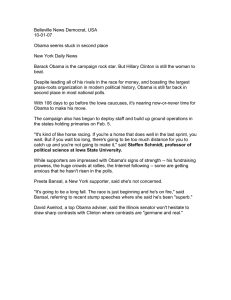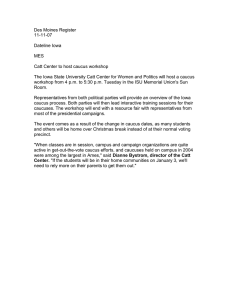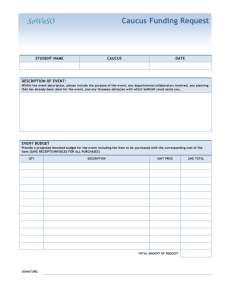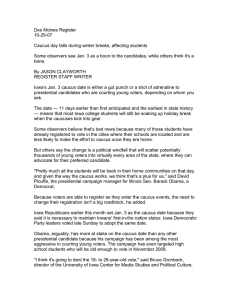Boston Globe 11-26-07 Obama's standing in Iowa poll shifts contest
advertisement
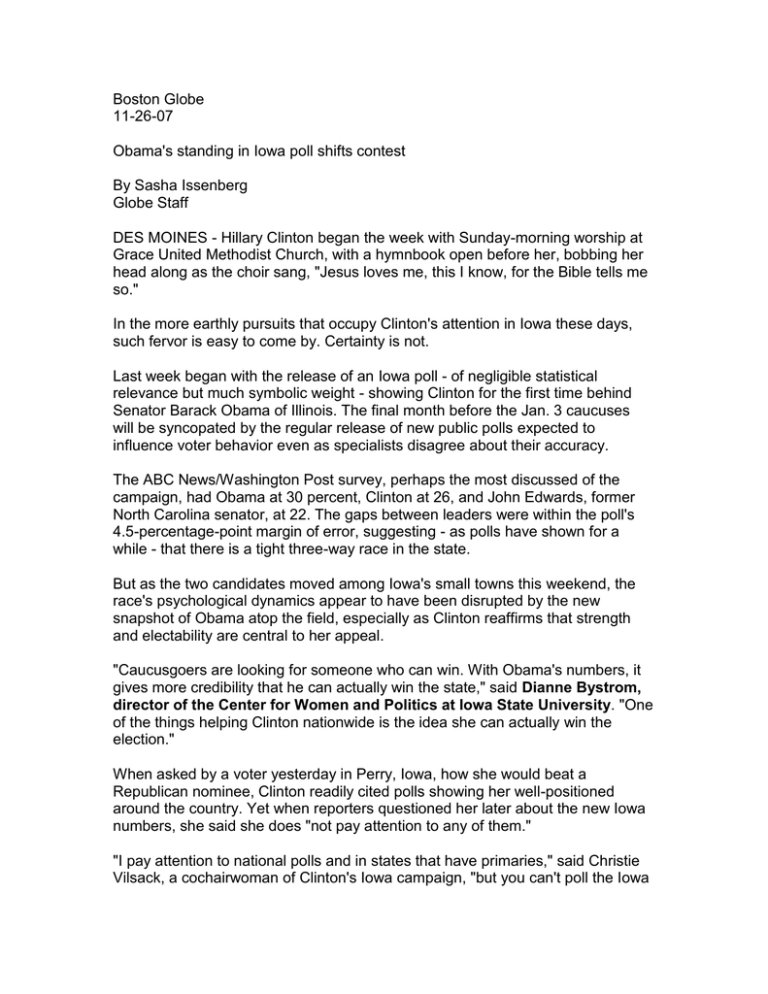
Boston Globe 11-26-07 Obama's standing in Iowa poll shifts contest By Sasha Issenberg Globe Staff DES MOINES - Hillary Clinton began the week with Sunday-morning worship at Grace United Methodist Church, with a hymnbook open before her, bobbing her head along as the choir sang, "Jesus loves me, this I know, for the Bible tells me so." In the more earthly pursuits that occupy Clinton's attention in Iowa these days, such fervor is easy to come by. Certainty is not. Last week began with the release of an Iowa poll - of negligible statistical relevance but much symbolic weight - showing Clinton for the first time behind Senator Barack Obama of Illinois. The final month before the Jan. 3 caucuses will be syncopated by the regular release of new public polls expected to influence voter behavior even as specialists disagree about their accuracy. The ABC News/Washington Post survey, perhaps the most discussed of the campaign, had Obama at 30 percent, Clinton at 26, and John Edwards, former North Carolina senator, at 22. The gaps between leaders were within the poll's 4.5-percentage-point margin of error, suggesting - as polls have shown for a while - that there is a tight three-way race in the state. But as the two candidates moved among Iowa's small towns this weekend, the race's psychological dynamics appear to have been disrupted by the new snapshot of Obama atop the field, especially as Clinton reaffirms that strength and electability are central to her appeal. "Caucusgoers are looking for someone who can win. With Obama's numbers, it gives more credibility that he can actually win the state," said Dianne Bystrom, director of the Center for Women and Politics at Iowa State University. "One of the things helping Clinton nationwide is the idea she can actually win the election." When asked by a voter yesterday in Perry, Iowa, how she would beat a Republican nominee, Clinton readily cited polls showing her well-positioned around the country. Yet when reporters questioned her later about the new Iowa numbers, she said she does "not pay attention to any of them." "I pay attention to national polls and in states that have primaries," said Christie Vilsack, a cochairwoman of Clinton's Iowa campaign, "but you can't poll the Iowa caucuses unless you poll only the 120,000 people you know are going to come out." Despite the growing number of candidate signs along country roads here, caucus participation remains a niche activity among Iowa voters. As a share of registered voters, caucus turnout is historically less than one-third of that in New Hampshire's primary. "Predicting turnout with polls is a really hard thing," said Tom Lindenfeld, a Democratic strategist who has worked for Obama. In making projections, campaigns rely above all on their "hard count," a tally of voters who have pledged to support them, and a list of previous caucusgoers made available for sale by the state party But no media organization is believed to have purchased such a list, so instead of knowing who has participated in past caucuses - considered the best indicator of turnout - pollsters are random-dialing households and asking voters whether they have voted before and how interested they are in the current race. "People don't want to say no to that," said Gordon Fischer, a former chairman of the Iowa Democratic Party now supporting Obama. "They may not want to acknowledge they didn't caucus." The biggest challenge is in vetting those who say that January's caucus would be their first. The ABC survey showed Obama and Clinton relying on first-time caucusgoers for nearly half their support, while new voters represent one-quarter of Edwards's. Yet such inexperienced caucusgoers are often those making decisions with the least information, according to University of Wisconsin-Madison political scientist Charles Franklin. That inclines them in polls to ratify the standing of existing front-runners. "They're more likely to name the first candidate that comes to mind," Franklin said. The profile of each candidate's first-time caucus participants - given Obama's reliance on the very young and Clinton's on working women - suggests a range of conflicts that could influence turnout of new voters. For different voters, the weather, college-football programming, back-to-school schedules, and alienation from increasingly negative campaigning could have differing effects on caucus-night attendance. Polls show Edwards's support coming more from middle-aged voters who are seen as the most reliable participants on caucus night. "The thing that's going to help Edwards is that in the past the typical Iowa caucusgoer has been in that baby-boomer range," Bystrom said. In 2004, polls indicated that more than one-third of Iowa Democrats made up their minds in the last weeks before the caucus, many appearing to shift to candidates John Kerry and Edwards because they were seen as the most viable general-election candidates. "As you get closer to the election, the people who are soft supporters and undecided, the dominant concern they will all have is who can win in the fall," Lindenfeld said. Even those who make up their mind do not always get to cast that vote on caucus night. Democratic caucus rules require a candidate to pass a threshold of 15 percent backing in a given precinct; supporters who come up short typically pick another candidate. In the ABC poll, Obama expanded his lead when voters were asked for their second choices, heartening his supporters who see an anti-Clinton bloc forming among backers of her opponents. Yet at a caucus, where voters must stand publicly on behalf of their candidate, the sorting-out often takes place under great social pressure and tactical alliances that override the second-choice scenarios posed by pollsters. "There's a big gap between saying that on the phone and what you actually do at your neighborhood caucus," Franklin said.
